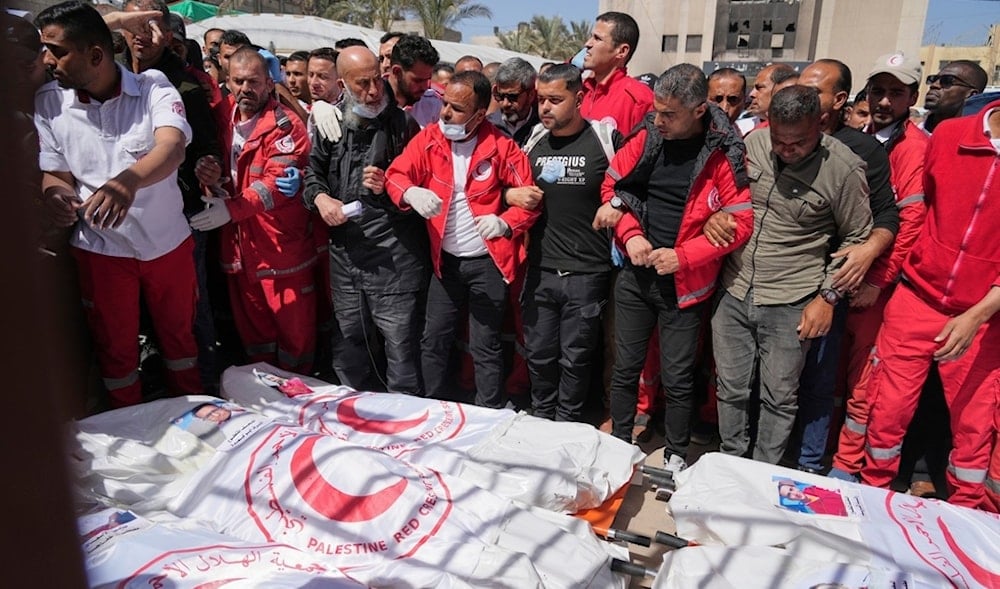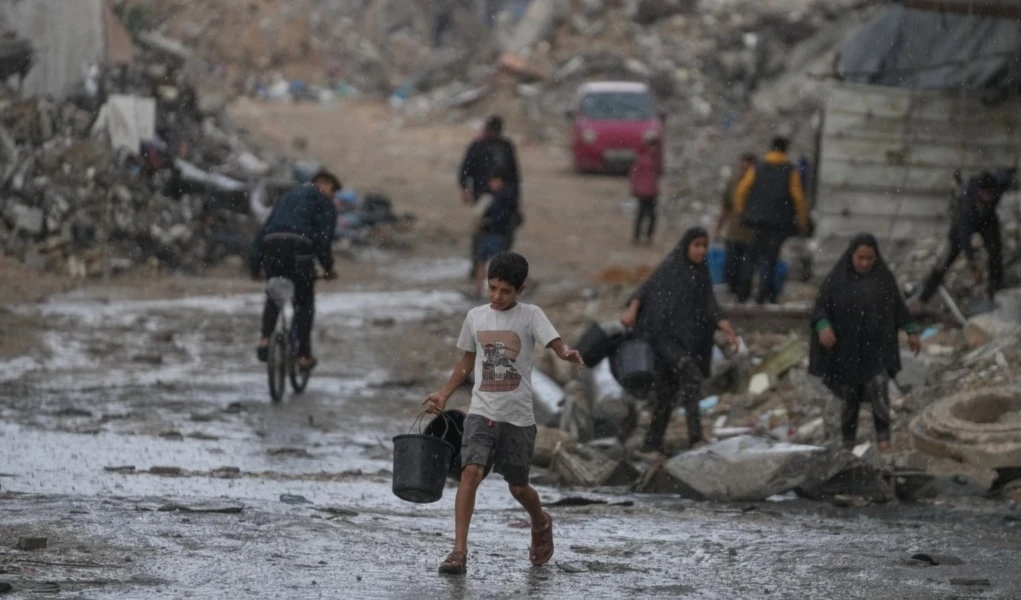'Israel' backtracks on lies as footage exposes murder of Gaza medics
The Israeli occupation has changed its narrative after being exposed for deliberately executing 15 paramedics in Rafah last month.
-

Mourners gather around the bodies of 8 Red Crescent emergency responders, recovered in Rafah a week after an Israeli attack, as they are transported for burial from a hospital in Deir al-Balah, Gaza Strip, on Monday, March 31, 2025 (AP)
The video footage exposing the Israeli occupation forces' execution of 15 medics in Rafah has forced "Israel" to backtrack on its fabricated narrative, claiming its lies were "unintentionally made".
Further claims were made and later debunked by video evidence, including that the ambulances did not have their emergency light on, and that the Israeli forces came under fire. The later Israeli military report claimed that the Israeli forces hid the bodies and the ambulances under the sand "to prevent them from being eaten by wild animals."
This procedure was unusual for their forces committing genocide and leaving bodies in the streets left and right for one and a half years intentionally, for them to be eaten by wild animals later on, which suggests that the IOF did it to hide evidence.
What actually happened
The New York Times obtained video retrieved from the cell phone of a Palestinian paramedic, whose body was discovered alongside 14 other aid workers in a mass grave in Gaza in late March, showing clearly marked ambulances and a fire truck with emergency lights activated as they came under heavy Israeli gunfire.
The Israeli military spokesperson, Lt. Col. Nadav Shoshani, had denied that Israeli forces had "randomly" attacked an ambulance. He claimed that multiple vehicles had been seen "advancing suspiciously" without headlights or emergency signals toward Israeli troops, prompting the shooting. He also claimed that nine of the individuals killed were Palestinian Resistance fighters.
However, a seven-minute video shot from inside a moving vehicle was recovered, depicting a convoy of ambulances and a fire truck, all clearly marked and displaying both headlights and flashing emergency lights, driving southward on a road north of Rafah just after sunrise.
The convoy halts when it comes across a damaged ambulance on the roadside—an earlier vehicle sent to aid injured civilians had reportedly come under attack. The new rescue vehicles move to the side of the road. At least two uniformed rescue workers are seen exiting the fire truck and ambulance, both bearing the Red Crescent emblem, and approaching the damaged vehicle.
Suddenly, intense gunfire erupts. The barrage of bullets can be seen and heard striking the convoy. The footage shakes and then goes dark, though the audio continues for five minutes with unrelenting gunfire. A man’s voice is heard in Arabic noting the presence of Israeli soldiers.
The paramedic filming the attack is repeatedly heard reciting the shahada, the Islamic declaration of faith typically spoken when facing death. He asks for forgiveness and expresses that he knows he is going to die.
“Forgive me, mother. This is the path I chose — to help people,” he says.
According to PRCS spokesperson Nebal Farsakh, speaking from Ramallah, the paramedic who filmed the video was later found with a gunshot wound to the head in the mass grave. His identity has not been made public due to concerns for the safety of his family still living in Gaza, a UN diplomat confirmed.
'Israel's' so-called investigation
The Israeli Kan 11 reported on Saturday that the Israeli military will present the findings of its investigation into last month’s targeting of ambulance crews in Rafah to Chief of Staff Eyal Zamir tomorrow.
According to the channel, the investigation was led by the commander of the Southern Command, Yaniv Assor, and revealed the sequence of events in the Tal al-Sultan area of Rafah.
The investigation claimed that “ambulances belonging to the Palestinian Red Crescent moved through the area in coordination with the army at 4:00 p.m., and at 4:30 p.m., a Hamas vehicle equipped with blue emergency lights arrived and came under fire from a unit belonging to the Golani Brigade, resulting in the death of one Hamas member and the arrest of two others.”
The report added that later, around 6:00 p.m., “a convoy of four ambulances arrived and stopped near the vehicle that had been targeted. Soldiers felt threatened and believed it to be an attempted attack, even though the medics were unarmed, prompting them to open fire,” denying that there was any “deliberate deception.”
Regarding the false claim that the ambulances were not using emergency lights—a claim debunked by video footage published by The New York Times—the Israeli military said that “the unit commander reported that no lights were visible,” which led to the gunfire, acknowledging a “gap in reporting.”
Read more: 15 martyred humanitarian workers retrieved with tied hands from Rafah

 5 Min Read
5 Min Read









